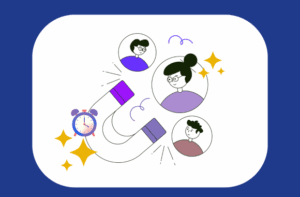Share
Employee engagement makes a night-and-day difference in the culture and performance of a company. Work-life balance is impossible when employees feel miserable and unappreciated. When workers are motivated and energized, it’s easier to solve problems. Engaged employees feel like they’re doing a good job and making a difference.
According to Gallup’s State of the Global Workplace report, 85% of employees are not engaged in the workplace
Who is responsible for employee engagement?
Everyone at your company plays a role in employee engagement. We all have opportunities to motivate and inspire each other, and everyone has a degree of responsibility for their own attitude. That said, HR carries the largest share of responsibility for company-wide engagement. Without the authority and influence of HR, individual workers have only a limited influence on their peers.
How can HR improve employee engagement?
HR staff has the chance to learn about the average employees and communicate directly with the CEO and upper management. Here are just a few of the ways HR can encourage and inspire engagement.
Effectively measure employee engagement
How do you know your employees are feeling engaged and motivated? “I know it when I see it” is true sometimes, but that doesn’t give you measurable data for month-to-month and year-over-year trends. Use multiple indicators that you can track over a longer period:
Performance management
Collect the right data from performance management reviews. Schedule regular 1-1s and performance reviews that include clear objectives and goals to achieve better employee engagement. Record and compare the results from one review cycle to the next with proper data and documentation. And finally, always establish expectations and plan a timely follow-up.
Manager effectiveness
Follow team performance and other key metrics for manager effectiveness. You can’t have an effective and motivated team as long as your leaders and coaches are ineffective. Even small things like frequent one-on-one meetings help employees feel valued.
Retention
Unhappy, disengaged workers are more eager to find jobs elsewhere. Test different HR strategies to reduce turnover. Equal pay and industry-standard raises are important. Mental health in the workplace is more important than ever. Companies can and should do more for working parents.
Surveys
When companies decide to measure employee engagement, too many rely on questions added to a lengthy annual review. In order to identify changes in a timely manner, engagement surveys should be used a few times a year. Ask the right questions on your employee surveys. Include simple, numerical ratings so that quantitative results will show trends over time.
HR data
Track KPIs for individuals and teams. Manage tardiness and absenteeism by seeing which policies reduce undesirable behaviors. By leveraging actionable insights, HR professionals can:
- Make data-driven decisions that positively impact the organization’s bottom line.
- Proactively address critical HR challenges and optimize workforce performance.
- Streamline processes and reduce administrative burdens, freeing up time for strategic initiatives.
- Foster a positive company culture and attract and retain top talent.
- Drive revenue growth by aligning HR strategies with business objectives.
Stay interviews
Respond proactively to employee turnover by encouraging candid feedback in stay interviews with current staff. Identify morale problems and conflicts before they escalate. Uncover new opportunities, prioritize the retention of reliable workers, and reduce (or altogether avoid) the higher costs of recruiting
Provide better technology + tools
Help employees feel empowered with mobile-friendly self-service portals. Invest in compatible software that automates the most tedious, repetitive tasks. The average worker may not realize how many human errors are possible with older HR software, but they’ll appreciate reliable, accurate paychecks.
Promote 1-on-1s between managers and employees
Make the time to schedule frequent meetings between employees and their managers. Use these meetings to set, measure, and track employee goals. Workers will feel more engaged when they see themselves achieving their own goals. Productivity and KPIs still matter, but regular meetings should be a two-way conversation.
Communicate clearly and consistently as HR
Use multiple communication channels and be consistent. Make sure policies are updated in the employee handbook, and don’t be afraid to make appropriate use of social media.Format your communication with clear subheadings, short paragraphs, and other best practices for HR comms.
Make onboarding more comprehensive
Sets the stage for success by using HR software to avoid common onboarding mistakes, like poor organization and slow response times. Make new hires feel connected, going beyond the bare minimum. The onboarding process demonstrates whether or not your company expects workers to use their time efficiently.
Develop and deliver on HR initiatives
While other departments focus on products and customers, HR can address employee engagement directly. Diversity, Equity, and Inclusion (DEI) initiatives give everyone a seat (and a voice) at the table. Develop HR initiatives that reflect the unique priorities of your workforce, and make sure that your words are backed up with meaningful action.
Increase recognition and incentives
Use a combination of public and private recognition to celebrate achievements. Promote a culture of encouragement and appreciation, especially at the team and supervisor level. Bigger incentives might include holiday bonuses and development opportunities.
Encourage team building + company events
Help employees build friendships by planning a company-wide event. Bigger company events require planning and organization, but they promote networking and a sense of belonging.
Foster professional development + continued learning
You can’t offer everyone a promotion or guaranteed raise, but you can provide ongoing learning and training for professional development. Upskilling is key to employee retention, and a Learning Management System (LMS) makes it easy to provide continued learning programs.
Connect with employees on what they care about most
What are the top priorities for your employees? What causes are they passionate about? Use surveys and anonymous feedback tools for honest communication. A workplace giving program connects your company with a favorite charitable cause, while others will be more motivated by perks and benefits that help their families.
Create a less stressful and more enjoyable work environment
Insufficient and unclear communication creates confusion. Provide benefits information and deadline reminders to reduce employee stress during open enrollment. HR staff can change the mood as well as the company culture. Too many spontaneous, half-baked HR activities can add stress for workers.
Discover how Netchex can help your HR department increase employee engagement:
Industry news & tips sent straight to your inbox!
Enter your email below to subscribe to industry news, product updates, and tips.
Related articles

How Financial Wellness Strengthens Teams, Boosts Retention, and Keeps Business Moving

Retention Strategies for Fitness Staff: Enhancing Operational Efficiency

Best Practice Guide for Improving Your Hourly Worker Employee Experience

